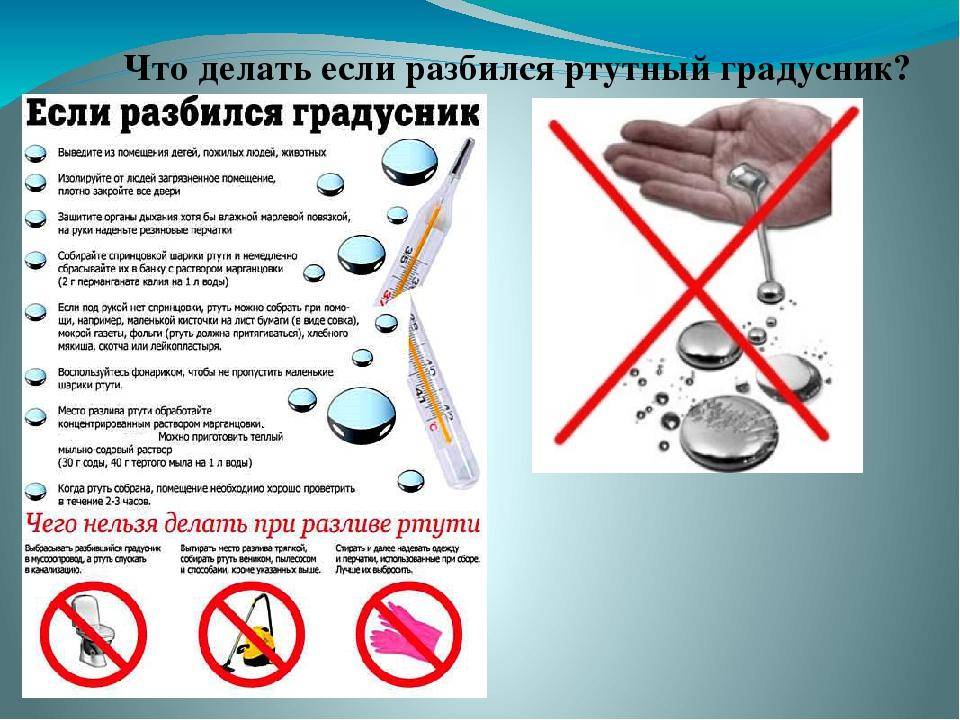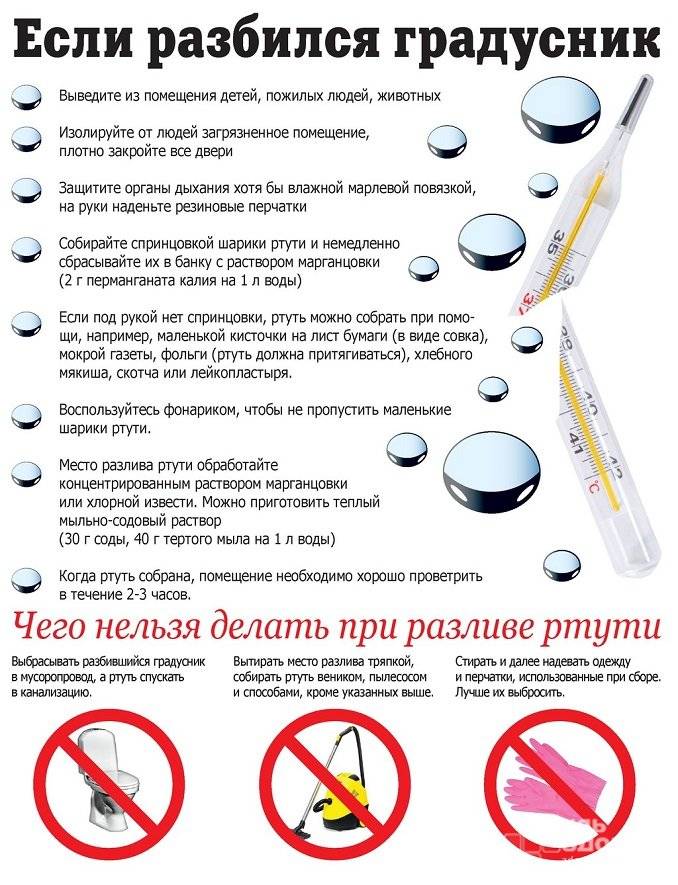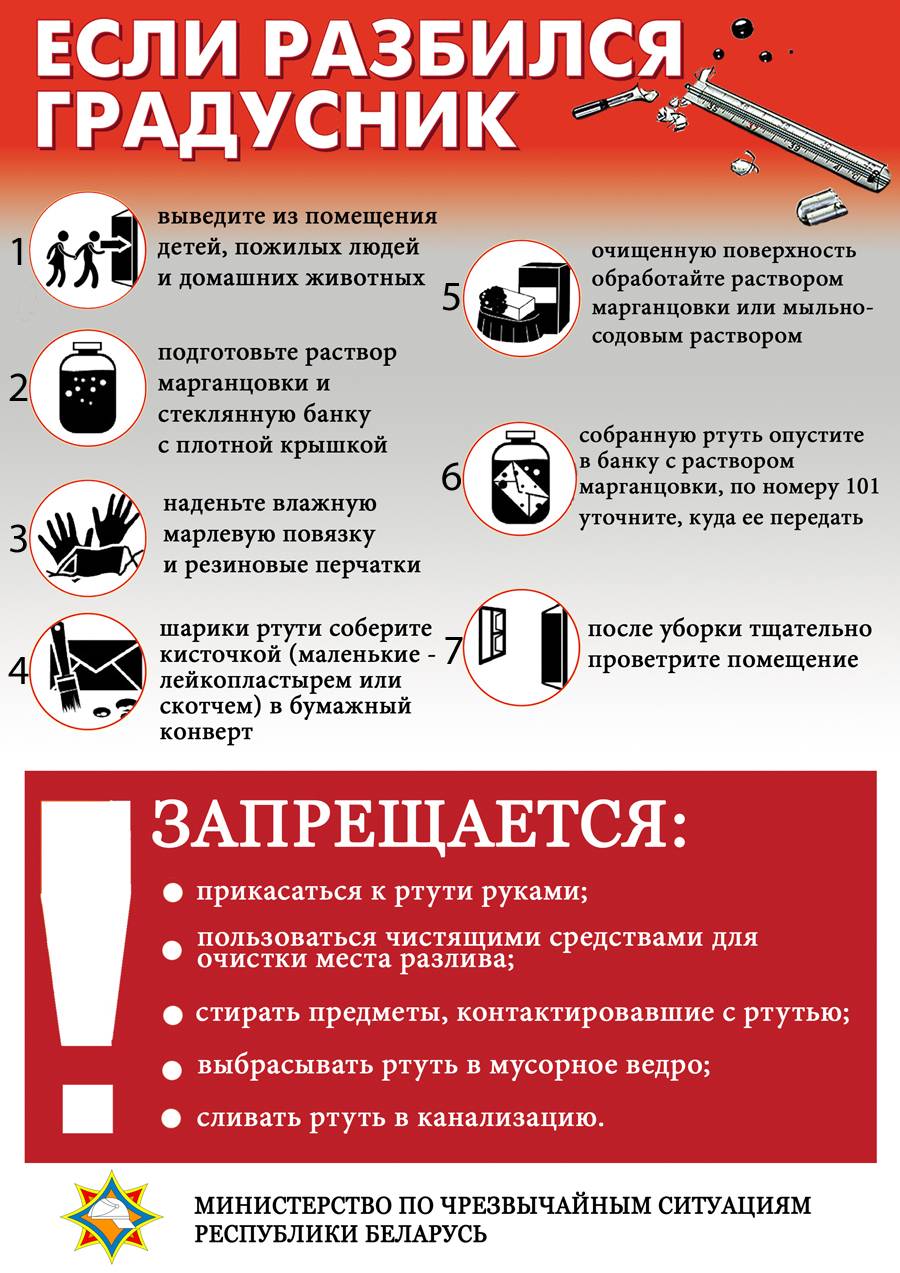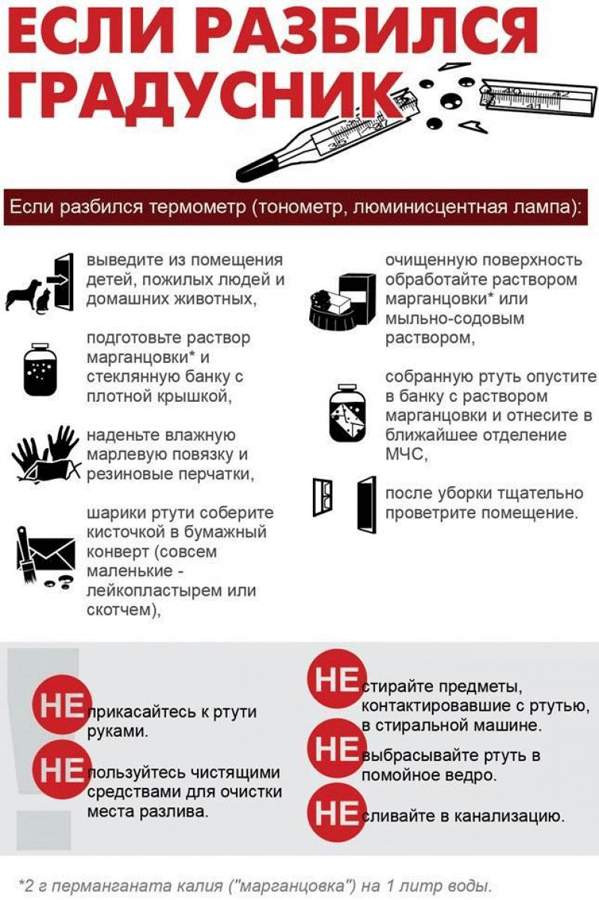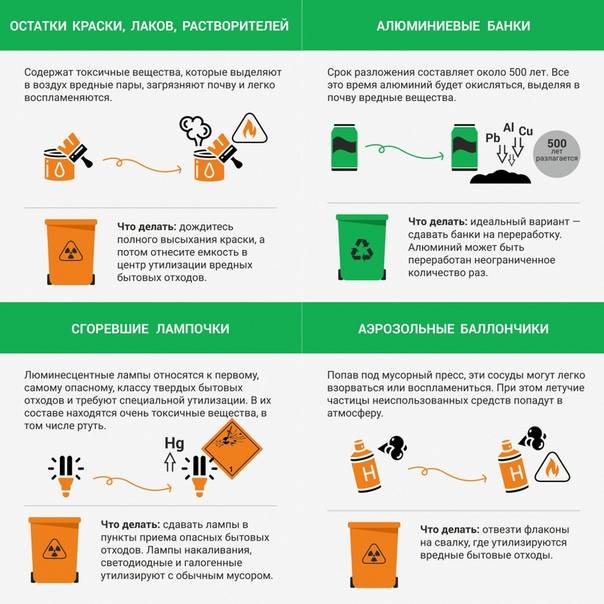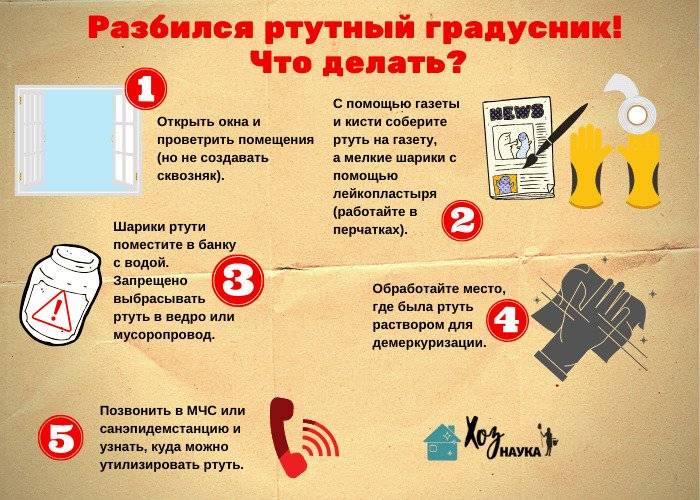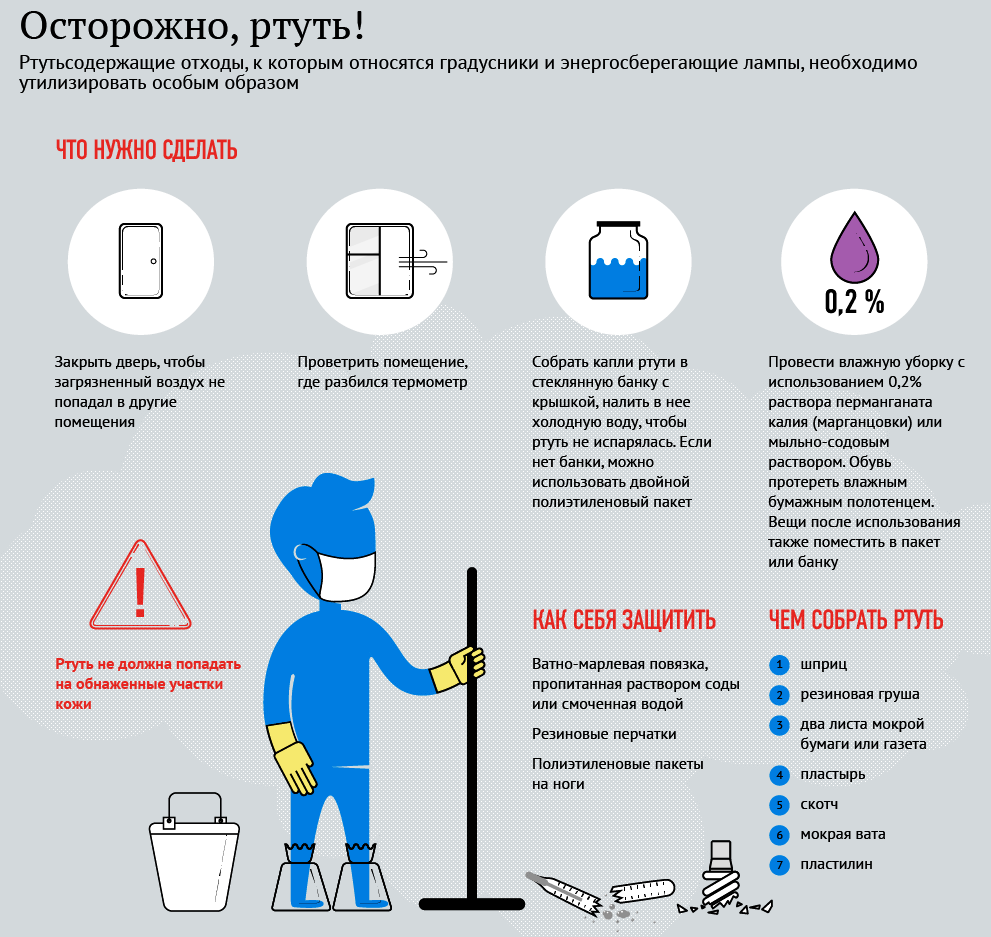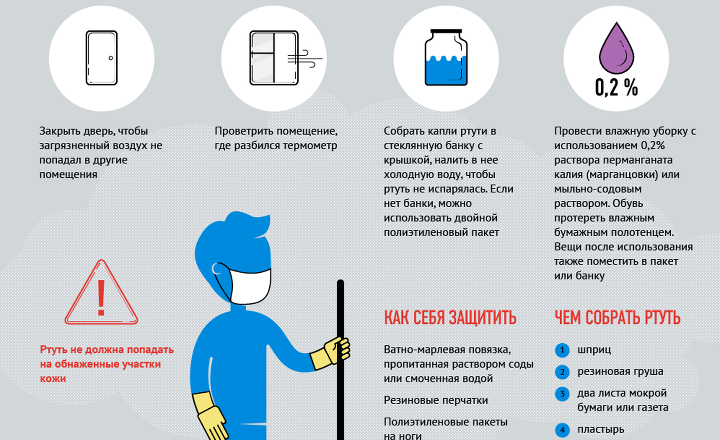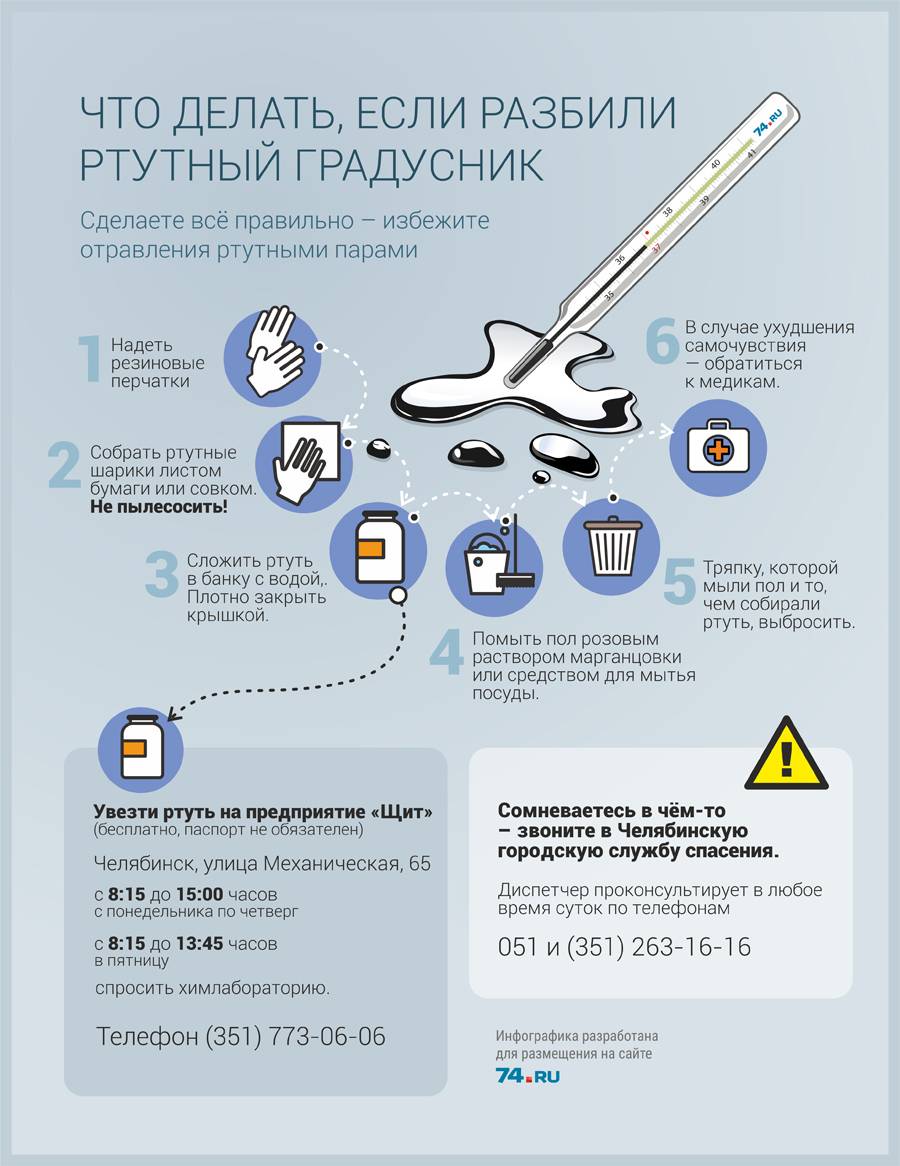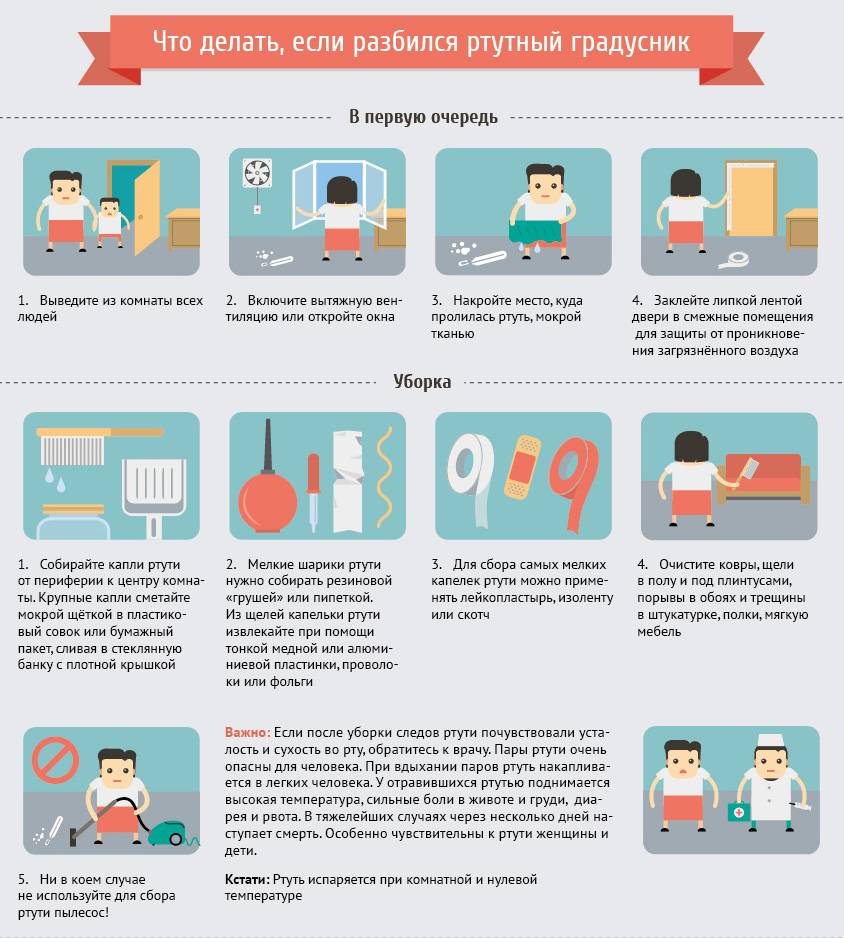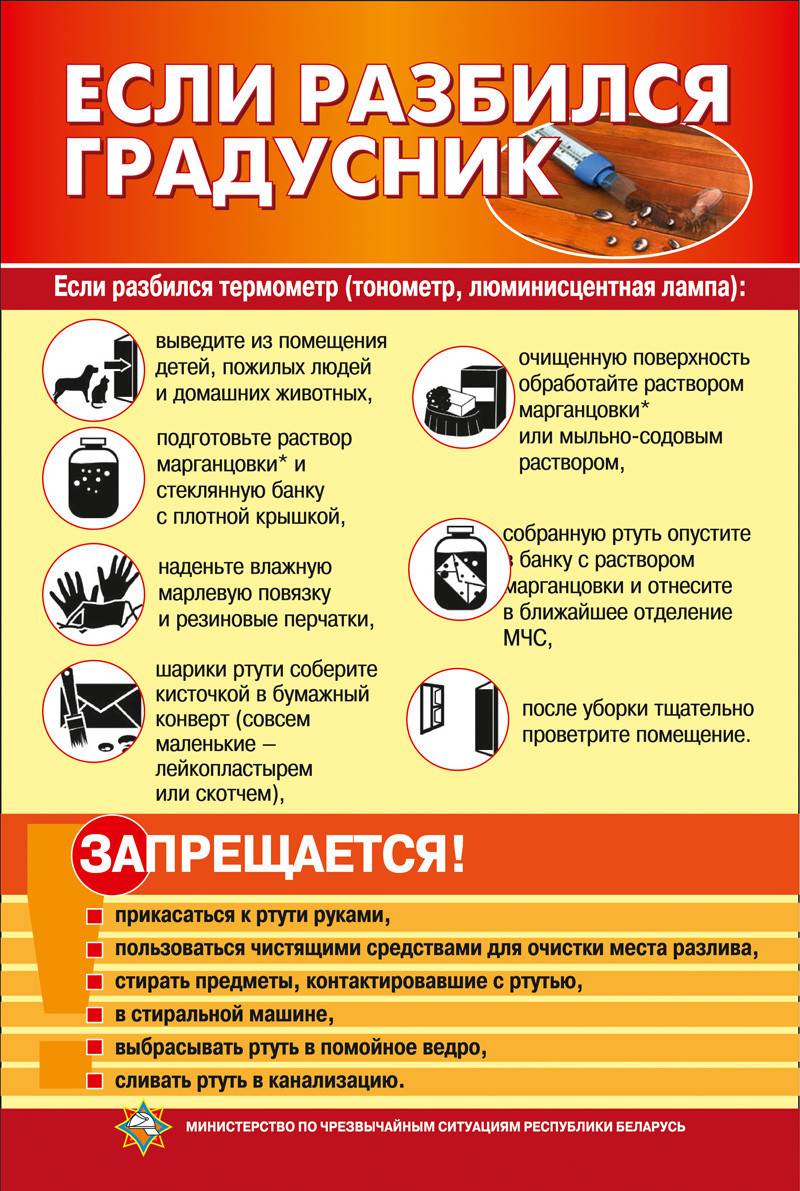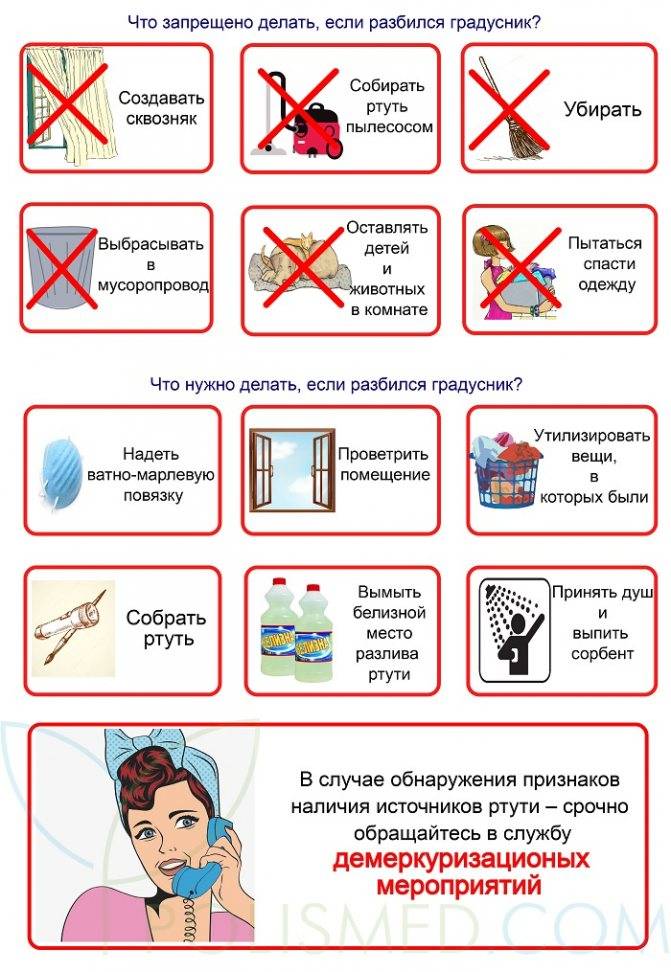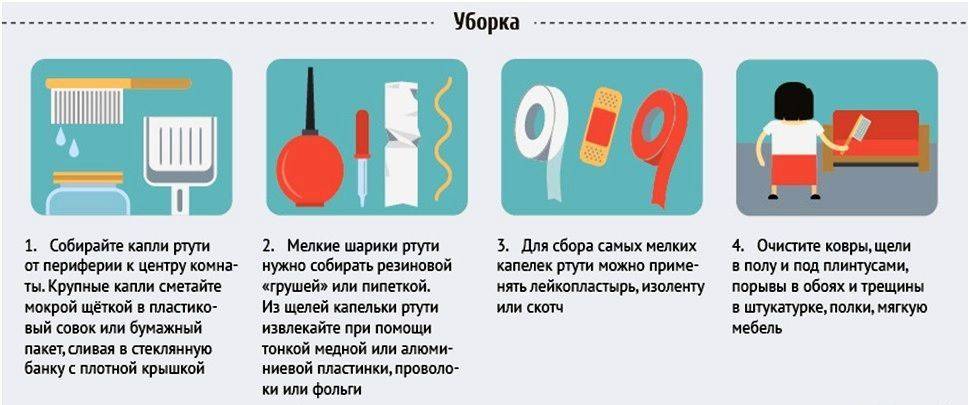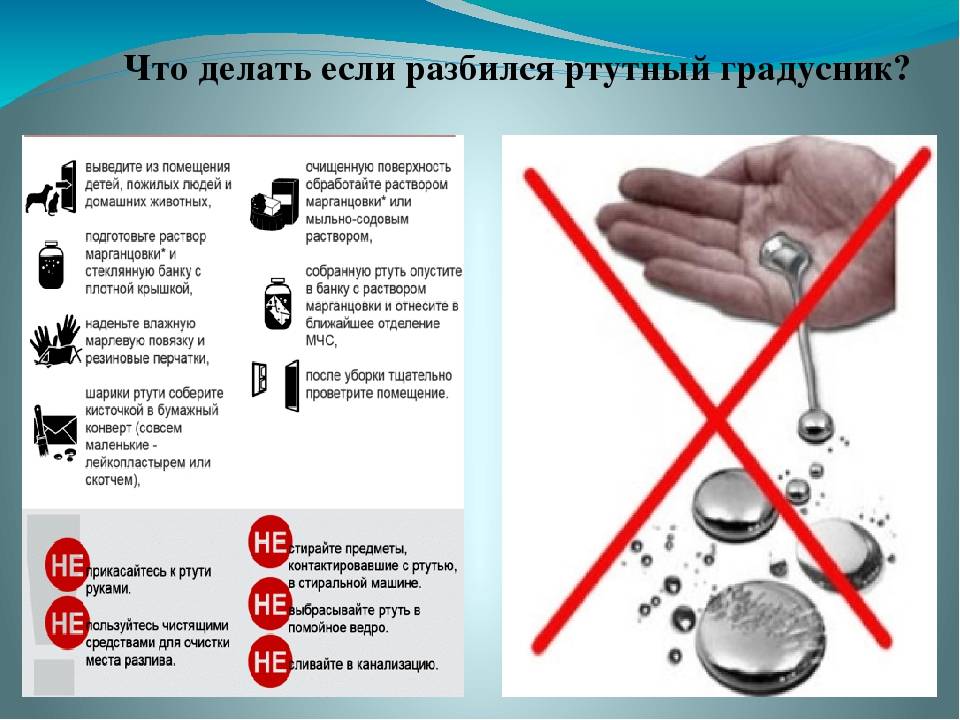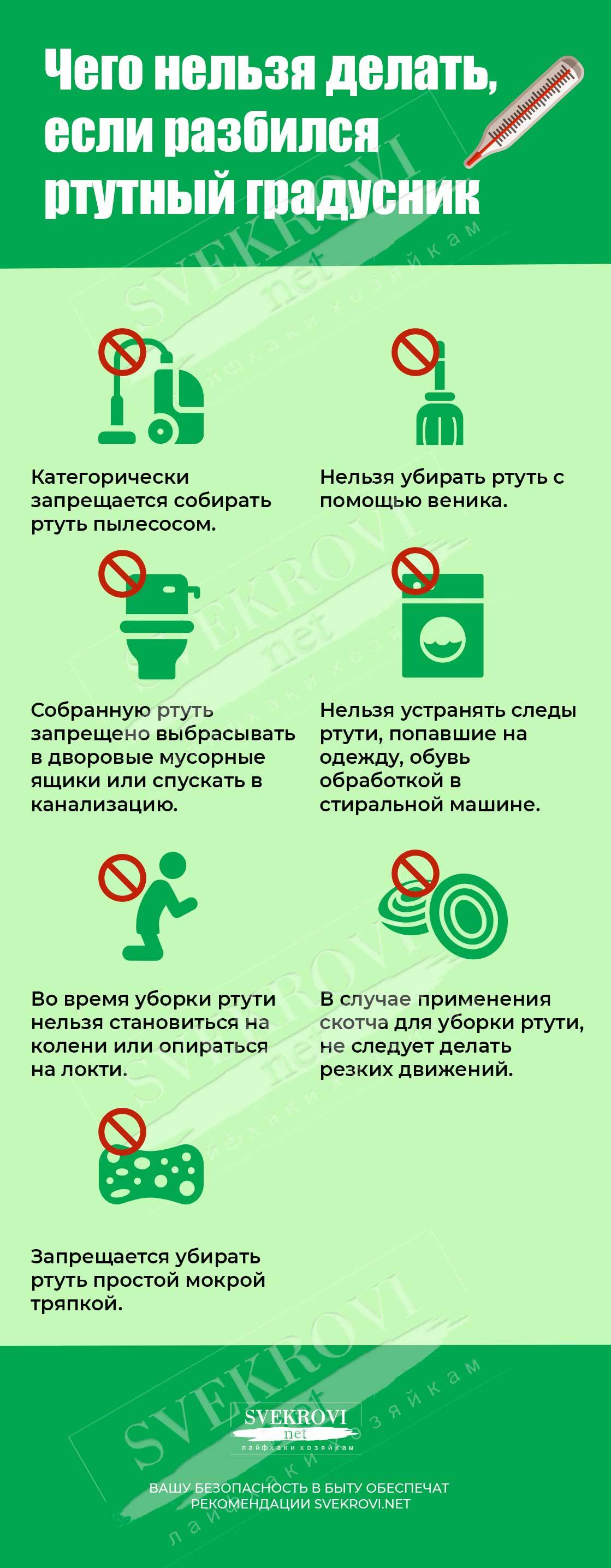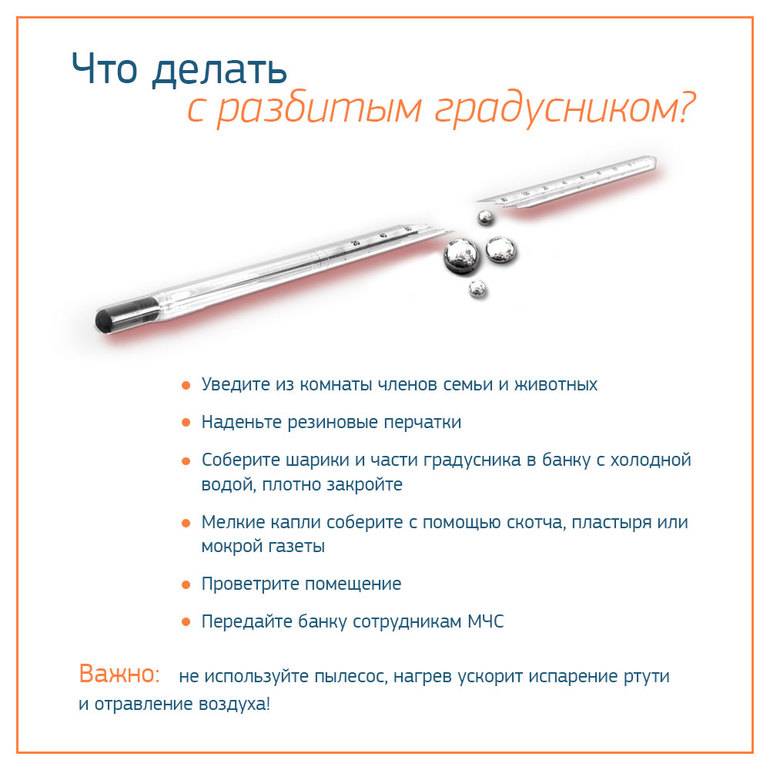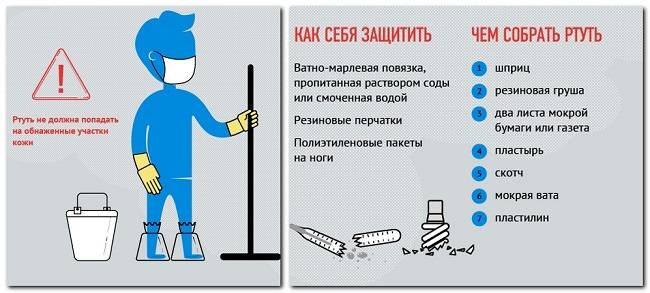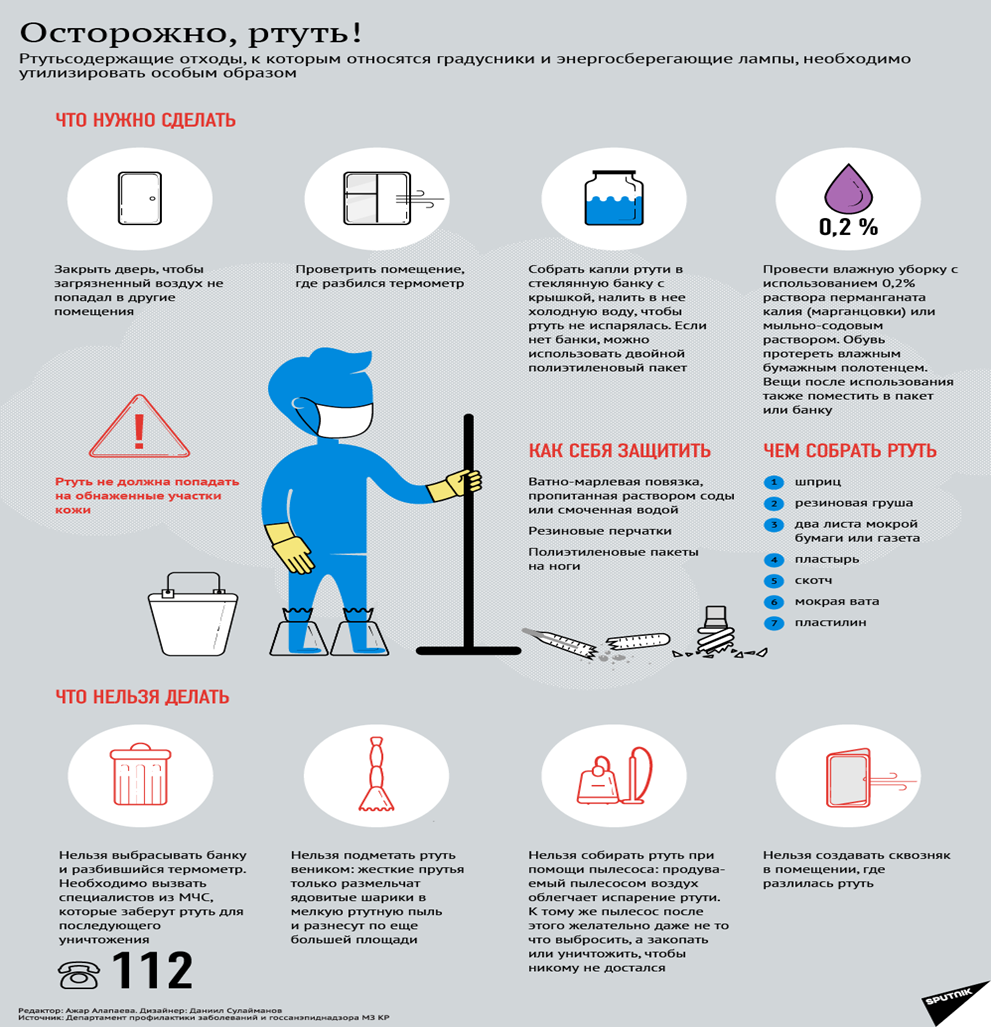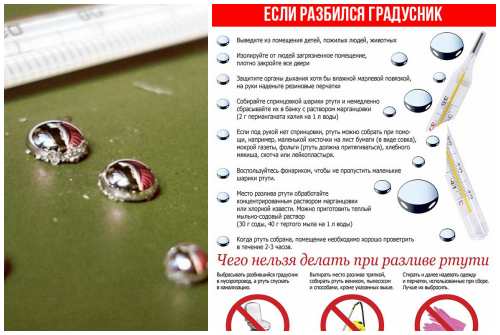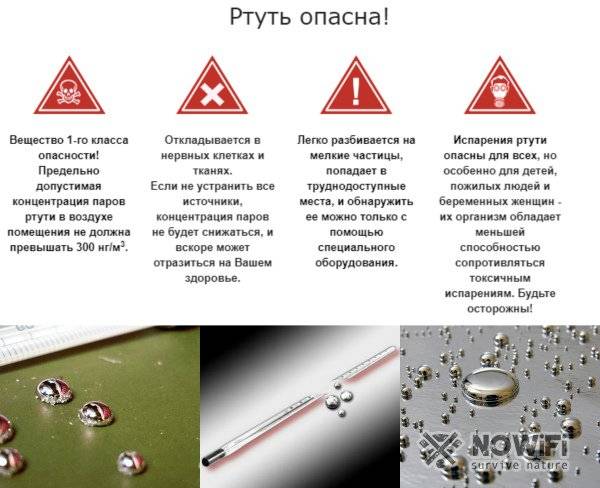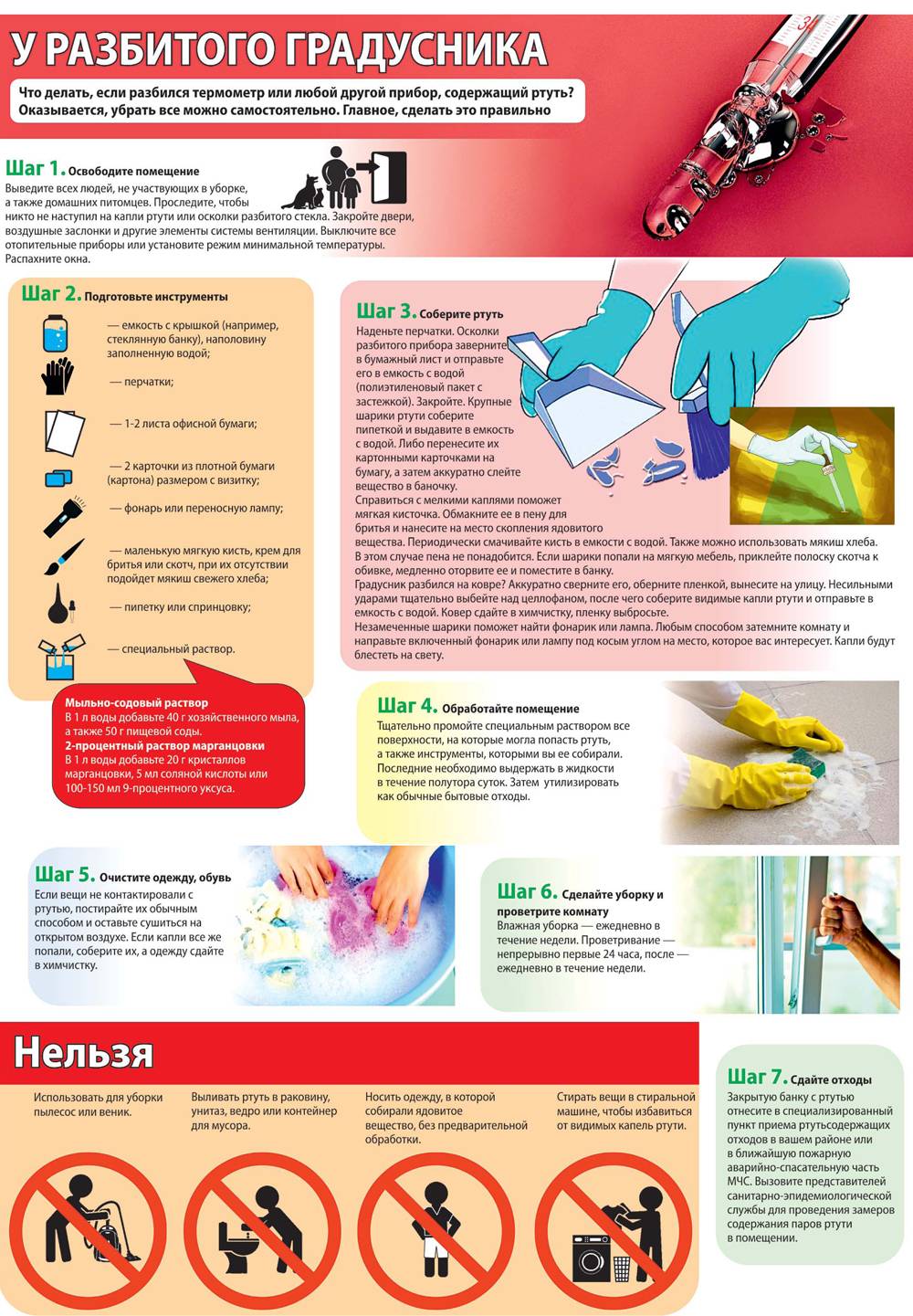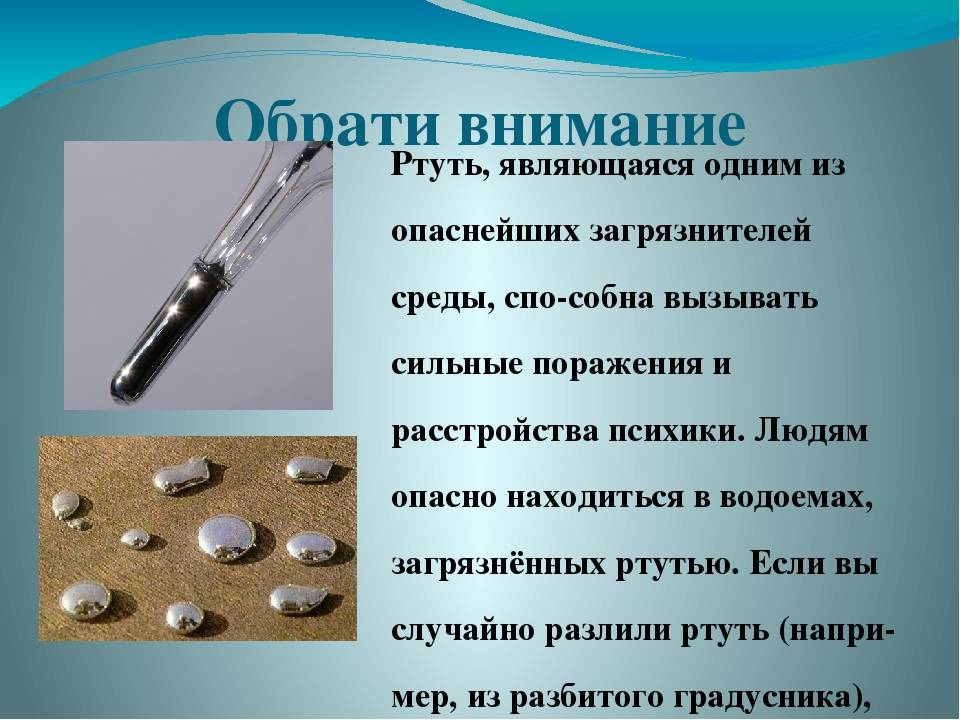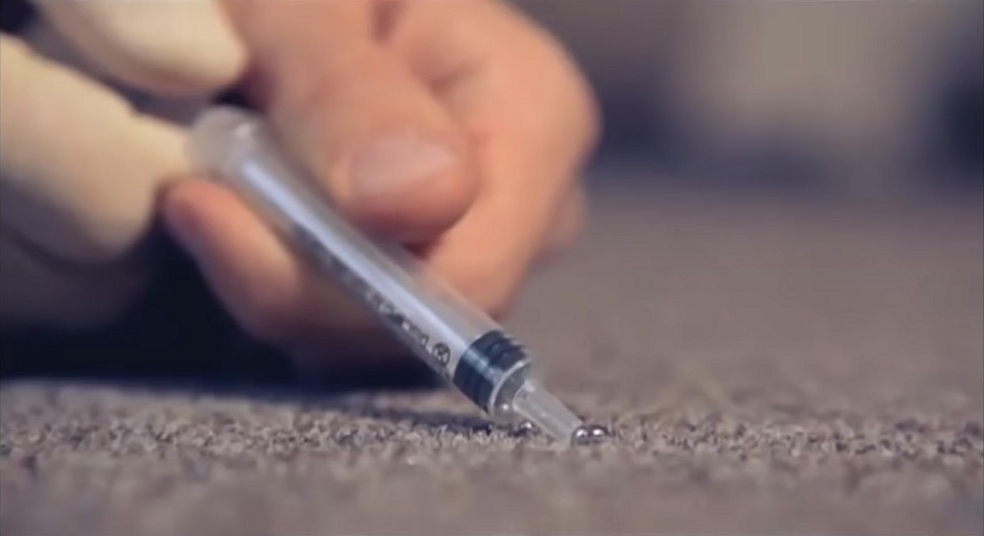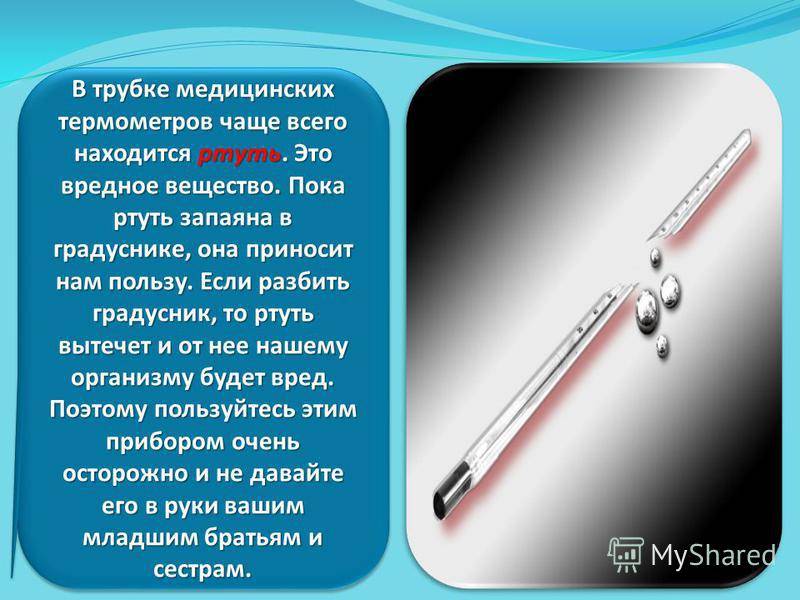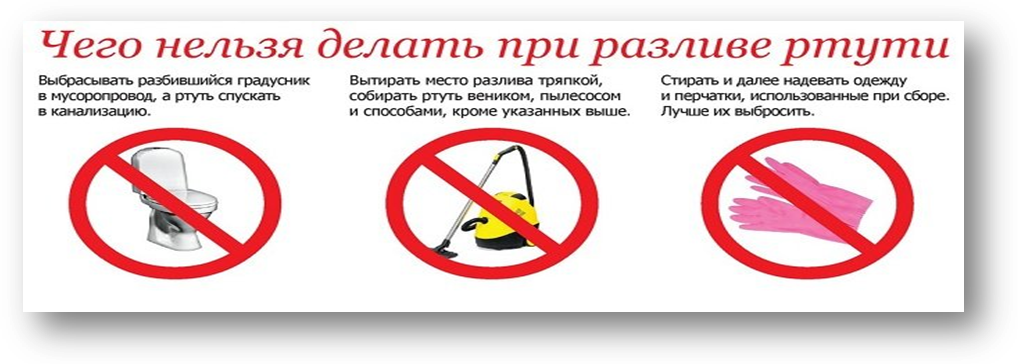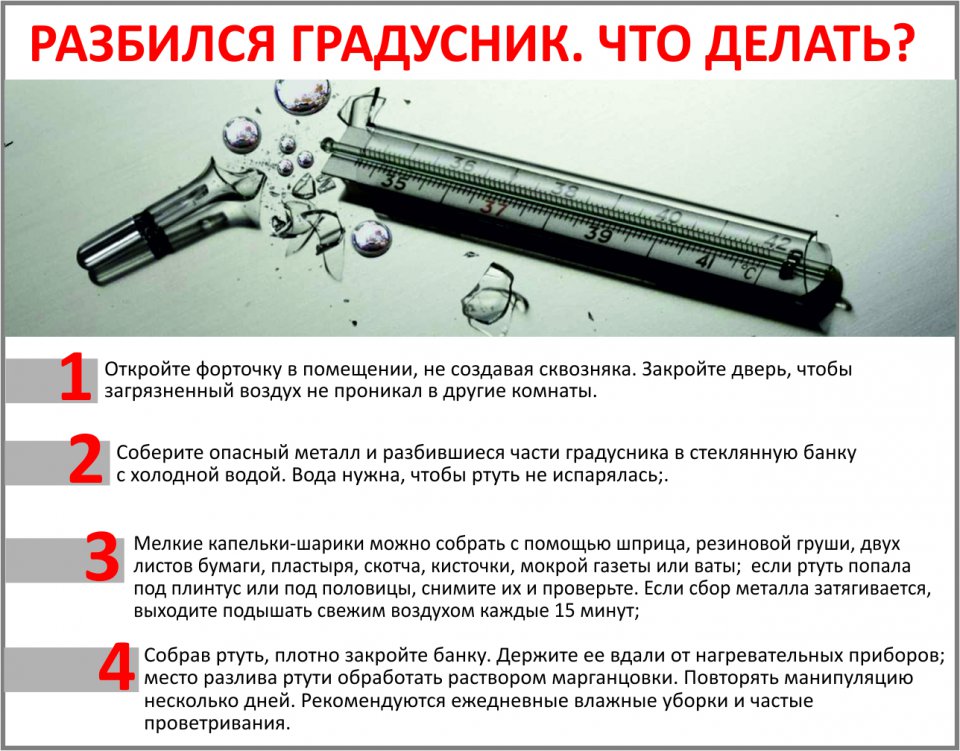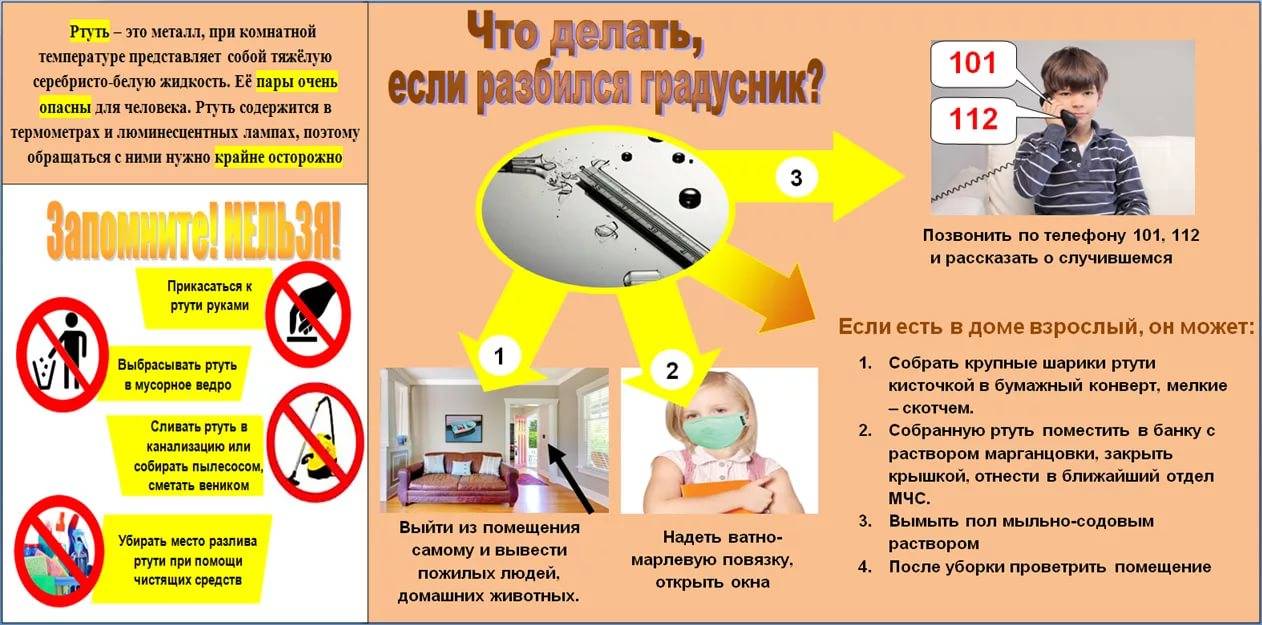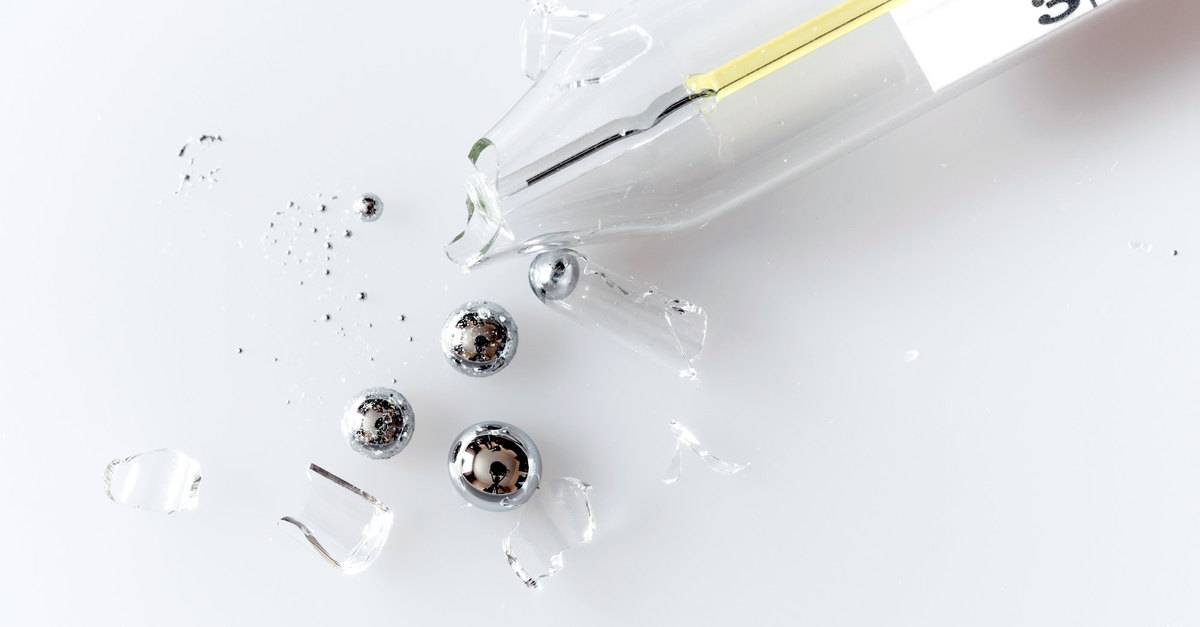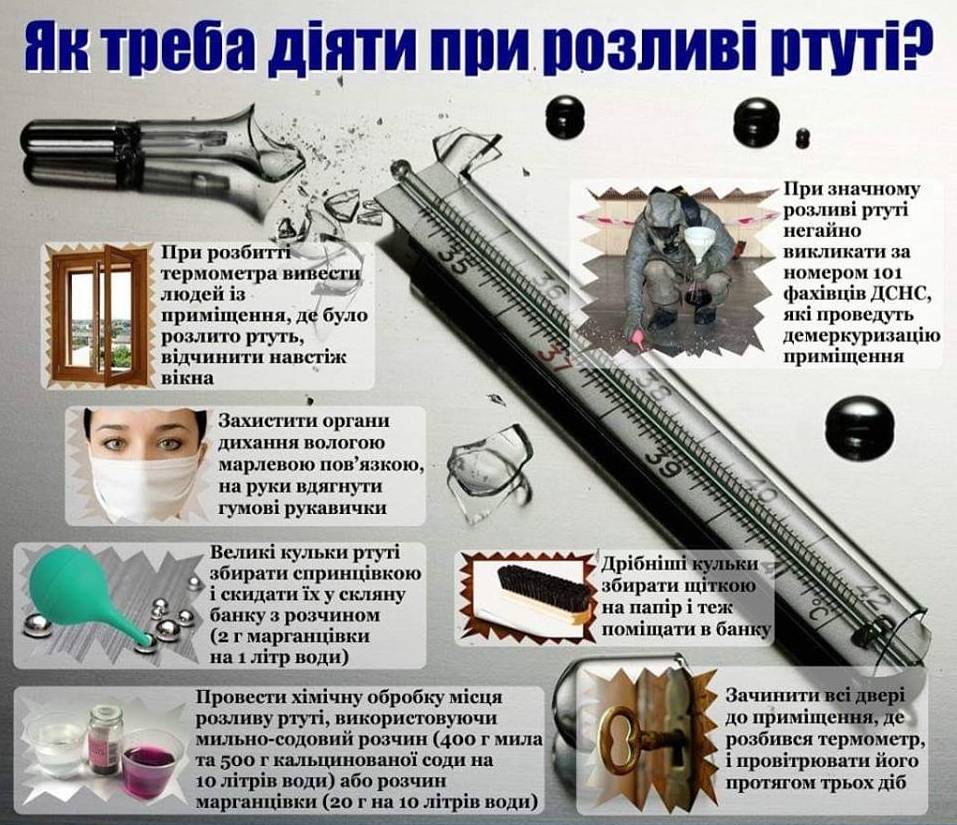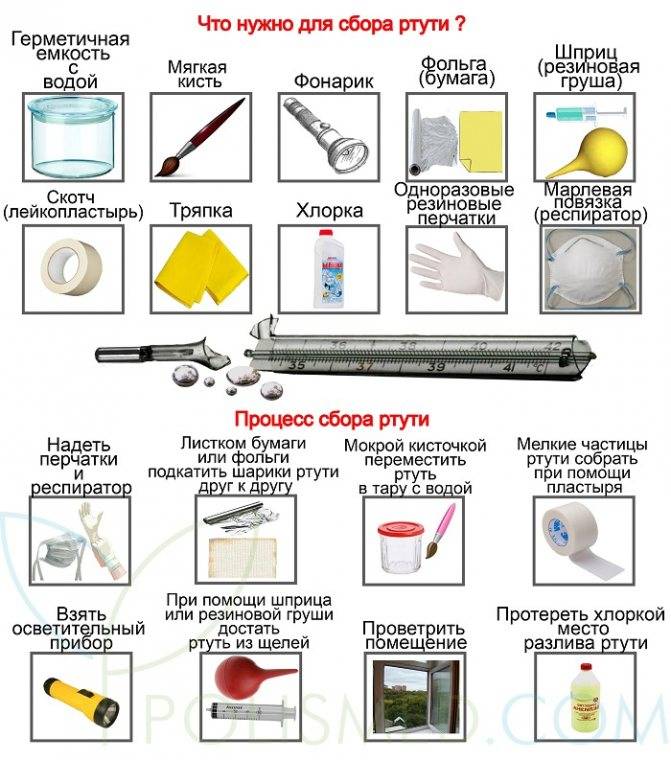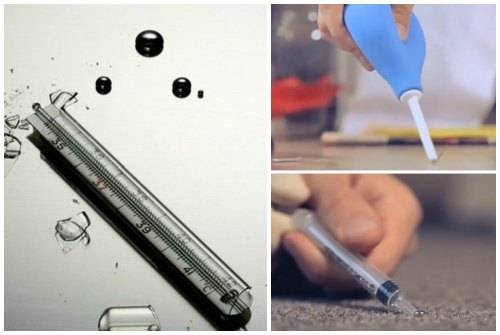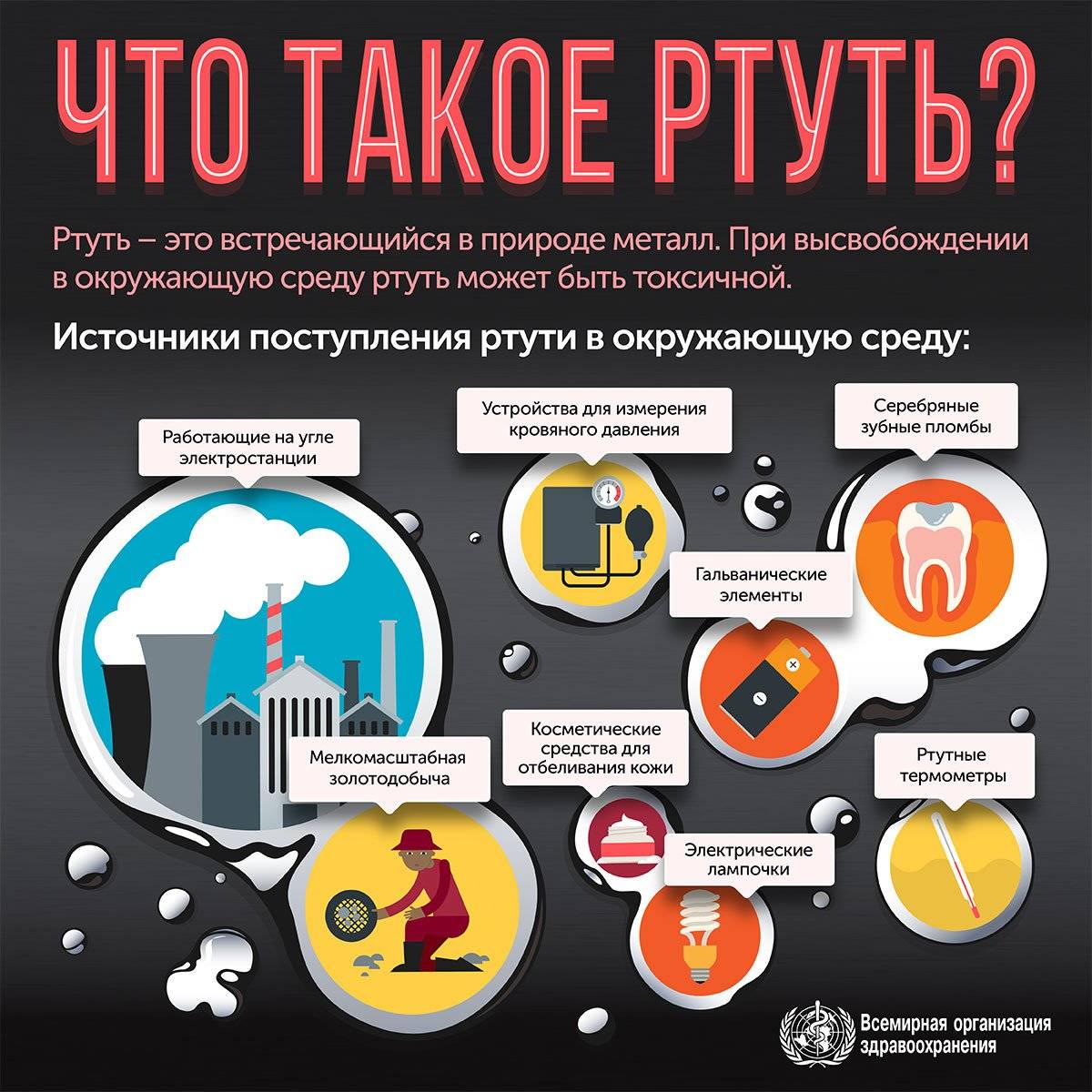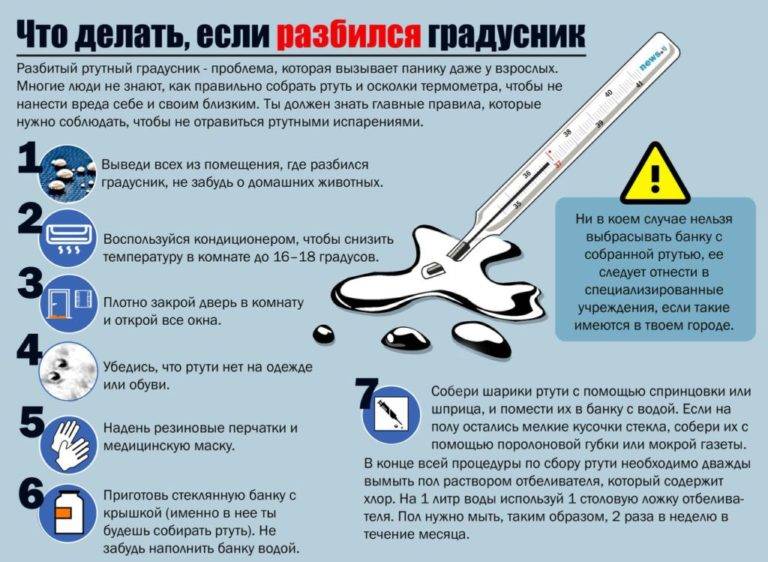Mercury hits difficult surfaces
When a toxic substance hits a hard surface, it breaks into small fragments and rolls around the room. The droplets are very small and difficult to detect, especially on light colored floors. In such cases, it is necessary to carry out a complete wet cleaning with the shift of upholstered and cabinet furniture. If the appliance crashes near the wall, remove the skirting board, check and clean the space under it.
Wipe the floor with smooth movements from the walls to the center of the room. To concentrate the collected material at one point, you need to put a wet cloth rolled up in a semicircle on the floor. It is better to use a scoop and a napkin to grab the glasses, and wet wipes and a sheet of paper for balls. After finishing the work, you need to make the right decision on how to dispose of the mercury thermometer. To clean the room from vapors, it is advisable to install a disposable air carbon filter.
It is more difficult to solve the problem if the material hits difficult surfaces.
Carpet
The pile of carpets and rugs has excellent sorbing properties. Balls of metal under the influence of gravity penetrate deep into the coating, regardless of its composition and height. It is impossible to remove metal from carpets by knocking them out, washing or airing them. Only a powerful industrial vacuum cleaner can help in such cases. But it is contraindicated to carry out such work at home, as this will contribute to the increased emission of toxic liquid vapors.
Soft furniture
Any upholstered furniture has many grooves, cracks and seams. A toxic liquid fills them up immediately if spilled. In addition, the upholstery, including leather, has micropores, into which small drops and mercury molecules penetrate. This substance is especially well absorbed into natural fabrics. It is almost impossible to remove it from such surfaces. Even after thorough mechanical and water cleaning, a small amount of heavy metal will remain in the fabric, which will release toxic compounds.
The situation is not irreparable. Furniture can be saved by replacing its upholstery. The material removed from the soft part must be packed in an airtight plastic bag, find out where to take the mercury and take everything to the specified address.
Such a familiar thermometer
With glass thermometers with a thin vacuum flask filled with mercury - a capillary, and a scale of divisions, everyone is familiar from childhood. This is the most common and necessary medical device in any family. Yes, now you can buy electronic thermometers of various shapes - from designed for babies in the form of a nipple to non-contact. But still, the vast majority of people consider mercury thermometers to be the most accurate and practical. Here are just a few think about the danger lurking in the thermometer.
Why, it would seem, was it necessary to invent a mercury thermometer, if a substance that helps to measure body temperature is very dangerous? But it was mercury that became the liquid that satisfies the needs of accurate temperature measurement, expanding evenly with its increase, rising up the capillary of the thermometer. The mercury thermometer was invented in the 18th century as an improved version of the alcohol thermometer. In our country, the Celsius scale is adopted to read the temperature, in the Western countries and in America, the temperature is measured in Fahrenheit. Using a mercury thermometer at home, few people think about the answer to the question "what neutralizes mercury" if the thermometer suddenly breaks.
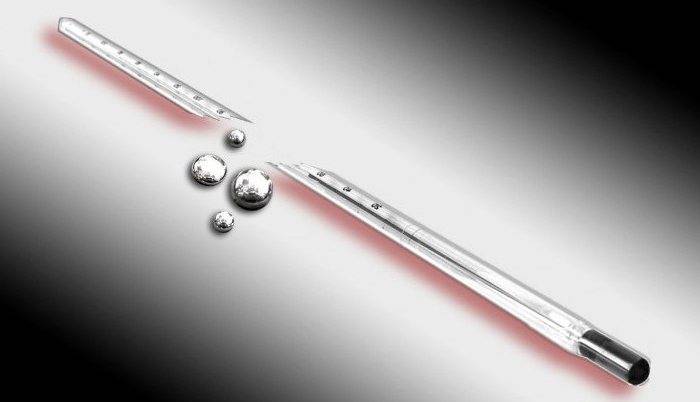
What absolutely must not be done
Making annoying mistakes when removing toxic balls of mercury can complicate the situation when getting rid of the problem becomes difficult and costly. By following simple rules, you can protect yourself and your loved ones from severe poisoning and long-term treatment.
In this case, it is important how long people have been in contact with the toxin.
We recommend:
How to remove creases on leather shoes
Forbidden:
- collect mercury with a broom, wipe with a wet cloth;
- use a vacuum cleaner and other household appliances;
- leave someone indoors;
- lower the silver balls and the damaged tip into the toilet or sink, throw it into the trash can or into the street;
- arrange drafts and ventilate with an open door;
- try to restore wardrobe items into which mercury has scattered;
- if a thermometer crashed in an apartment, do anything on your own, when there is no necessary equipment and other conditions.
Collecting mercury with a vacuum cleaner, rag or broom
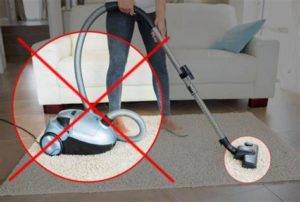 You won't be able to sweep the toxic balls with a broom, but you can accidentally divide them into even smaller segments and spread them around the room. Also, you cannot use a vacuum cleaner. The engine of the device will warm up, so the mercury inside will begin to evaporate, and its harmful vapors will enter the air through the air circulation system. If the device has been used, it should be handed over to a toxic decontamination specialist for further disposal. If you try to pick up the mercury with a damp cloth, you could accidentally rub hazardous particles into hard-to-reach areas.
You won't be able to sweep the toxic balls with a broom, but you can accidentally divide them into even smaller segments and spread them around the room. Also, you cannot use a vacuum cleaner. The engine of the device will warm up, so the mercury inside will begin to evaporate, and its harmful vapors will enter the air through the air circulation system. If the device has been used, it should be handed over to a toxic decontamination specialist for further disposal. If you try to pick up the mercury with a damp cloth, you could accidentally rub hazardous particles into hard-to-reach areas.
Leaving strangers in the house
Children and animals must be taken out of the apartment. Toddlers may be intrigued by the strange silvery balls and will want to touch them and take them to play. Cats and other pets will carry particles on their fur to other areas in the house.
Draft
The room should be ventilated, but under no circumstances should drafts be allowed. Even a light breeze can carry hazardous particles to other rooms, and it will be problematic to get rid of mercury completely.
Disposal into sewers or other prohibited places
Mercury cannot be disposed of not only in the sewer, but also in the garbage chute. It is also forbidden to throw it into the courtyard of a residential building.
Rules for handling mercury-containing waste. What does the law say?
The law on the rules for handling hazardous waste that can harm the health and life of people, representatives of flora and fauna, incl. from lighting fixtures was adopted in September 2010.
For refusal to comply with the rules for handling waste lamps, which contain mercury, individuals and legal entities face administrative liability (Article 8.2).
The amount of the fine for citizens is up to 2 thousand rubles; for officials - up to 30; for entrepreneurs - up to 50; for legal entities - up to 250.
Mercury and its compounds (mercury cyanide and mercury chloride) are potent hazardous substances.
Metal, its compounds, devices in which they are contained and their condition must be taken into account.
Hazardous waste should be stored in dedicated pantries with a good local ventilation system.
The law on the rules for handling hazardous waste that can harm the health and life of people, flora and fauna, incl. from lighting devices:
For refusal to comply with the rules for handling processed lamps, which contain mercury, individuals and legal entities face administrative liability (Article 8.2).
The amount of the fine for citizens is up to 2 thousand rubles; for officials - up to 30; for entrepreneurs - up to 50; for legal entities - up to 250.
Collect mercury on the floor or other surface
To collect toxic metal from a floor or other smooth surface, prepare the following items:
- disposable rubber gloves and shoe covers;
- a jar with cold water or potassium permanganate solution and with a tight-fitting lid;
- scotch tape, electrical tape or adhesive plaster;
- knitting needle or syringe (you can use a thick needle);
- ordinary cotton wool, a sheet of paper.
The algorithm for collecting toxic metal is as follows: put on gloves and shoe covers, collect the particles into one large ball with paper or a piece of cotton wool. On contact, the small balls merge. With cotton wool, drive a large ball onto a sheet of paper folded in the form of a scoop.
Gently dip the paper and all cleaning equipment into a jar of water. You can add potassium permanganate to the water. Close the container with a lid and take care of airing the room without a draft and disposing of all items that have come into contact with hazardous metal.
If the mercury has spread in an inaccessible place, then it is better to use a syringe or knitting needle. After capturing all the balls, you need to collect them in a container with liquid and close them together with the objects that have come into contact with them.
Other items can be used to collect the balls: wet newspaper, foil, soft brush, rubber syringe-pear. They should also be disposed of with mercury after cleaning. Rags should not be used.
If the balls fall under a floorboard, a plinth or a piece of furniture, then mercury may not be found. In these cases, you should take care of the immediate dismantling of the barrier or call the Emergencies Ministry brigade.
It is strictly forbidden to leave mercury without cleaning and adequate disposal! The consequences can be extremely dangerous! The room should be left before the arrival of the specialists.
How dangerous is mercury?
So, we found out how long it takes for mercury to evaporate in a room and at what speed this process takes place, from which it follows that 0.18 mg of poisonous vapor is released in one hour. Comparing this figure with the maximum permissible concentration (0.0003 mg / m3), we see a rather strong excess. But that doesn't mean anything yet. The fact is that the maximum permissible concentration is calculated taking into account the initial criteria - the threshold concentration for a long time - from six months to a year, and plus a guarantee amendment is applied to this, which further reduces this value by several times.
There is another quantity, which is defined as the weekly human dose of mercury. It is 5 mg per 1 kg of body weight. Thus, it is not difficult to calculate the maximum allowable dose for each family member.
And taking into account the volume of air consumed by a person (25 m3 per day), you can calculate the maximum permissible dose. To do this, multiply this value by the permissible level of mercury vapor (0.0003)
We get 0.0075 mg per day. We calculate the weekly dose by multiplying the result by 7.

And in order to understand how dangerous mercury from a broken thermometer is, you should determine the volume of air in the room that absorbs fumes. Calculations can be made by multiplying the length of the room by the width and height of the ceilings. In general, you should immediately find out the volume of air in the entire apartment. This is due to the fact that the vapors of this substance are volatile, and since mercury evaporates in a room for a long time, they will certainly spread throughout all rooms. So, with a total area of 60 m2 and a ceiling height of 2.7 m, we get a volume of 160 m3. We remember that the air is not static; with normal ventilation, 80% of the obtained indicator is replaced in one hour. Thus, the circulation automatically increases the volume of air that the mercury vapor consumes up to 300 m3.
The concentration of mercury can now be calculated. For this, the amount of evaporation (0.18) is divided by the volume (300). The result is 0.006 mg per 1 m3. We compare it with the acceptable level (0.0003) and understand that not everything is as bad as it might seem at first glance. Before us is a two-fold excess of the dose, which is not critical. However, it should not remain without attention.
Thus, knowing how much and for how long the mercury evaporates and disappears, one can easily determine its potential harm to a particular room and the people living in it.
Living and mercury
Mercury has been known to mankind since ancient times. The beautiful, scarlet stones on the fault are cinnabar - a natural mercury mineral, people mined to get a bright color, it is not for nothing that the stone in translation from ancient Persian is called "dragon's blood". And even then, mercury was used for amalgamation - one of the methods for refining gold.At the same time, it was known about the toxic properties of mercury compounds, such as mercury, which is still used today as a disinfectant. Mercury is a unique metal and begins to melt at about -39 degrees Celsius. Everyone has heard that she is very poisonous. Why mercury from a broken thermometer is dangerous to humans needs to be clarified.

If mercury gets into the open air, it begins to evaporate like water, and active evaporation begins already at 18 degrees Celsius. Mercury vapors saturate the air in the room, especially if it is not ventilated. And such air becomes dangerous for humans and pets, and even for indoor plants and fish in an aquarium. The peculiarity of this chemical element is that it is capable of accumulating, that is, accumulating, in a living organism, and it is almost impossible to remove it. Mercury accumulates until the critical limit of its concentration in the body comes. Moreover, at the first stages of such poisoning, the symptoms are so mild that they can be mistaken for fatigue, a slight cold, but not for a serious health problem, life-threatening.

If a mercury thermometer breaks
Everyone should know what to do when a thermometer with mercury has broken.
Urgent action
If the thermometer accidentally crashed, you need to take the following actions:
- remove people from the room, close the door and open the window to ventilate;
- wear protective gloves, respirator or gauze bandage;
- place a broken thermometer in the water and take it outside;
- ventilate the room for a month and treat the coatings with disinfectant solutions.
What can come in handy
There are a few things that can come in handy when cleaning a room from the remains of mercury balls.
Glass container with lid
To get rid of mercury particles at home that have scattered in the room due to a broken thermometer, you will need a container with a lid. It is used to store the collected balls. Before collecting mercury, water is collected in the container.
It is important that it is not too hot. The water should be warmed up to room temperature
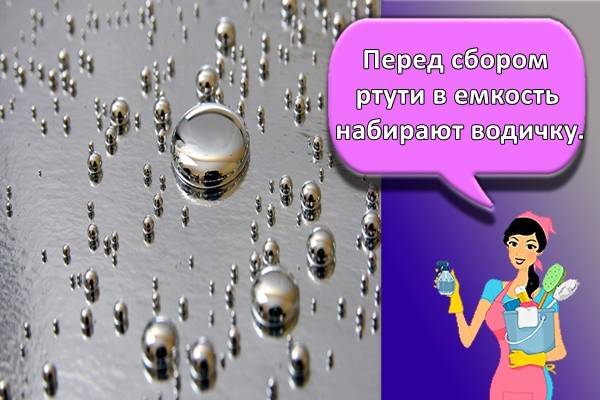
Syringe
Some people use a conventional medical syringe to remove particles of mercury from the surface.
First, you need to remove the needle, after which the syringe is carefully applied to the mercury ball and pulled inside. After collecting all the drops, the filled syringe is placed in a jar of water
Brush
You can get rid of the mercury with a regular shaving foam brush. To do this, foam is applied to the surface of the brush, after which it is rubbed over the area of accumulation of mercury balls.
After that, the foam applied to the surface must be carefully collected with a brush moistened with warm water. The procedure is repeated several times until the coating is completely free of mercury.
Adhesive tape
Another way to get rid of mercury balls quickly is duct tape. The main advantage of this mercury removal method is its ease of use. To get rid of small drops, you need to lower a small strip of tape with the sticky side on a dirty surface
After that, the glued tape is carefully lifted and placed in a pot of water.
Piece of cardboard
Sometimes, when removing mercury drops, use small pieces of ordinary cardboard
To do this, the balls are carefully scraped into a cardboard box and immediately discarded.
Garbage bags
It's no secret that before removing the droplets of mercury, you need to protect your feet and hands. Thick rubber gloves are used to protect the hands, and shoe covers are used for the feet. However, not all people have shoe covers and therefore trash bags can be used instead. They are put on your feet and tied with ordinary ropes. After cleaning, the bags are removed and disposed of.
Lantern
Sometimes mercury balls are difficult to spot as they can be found in dimly lit areas. That is why during the cleaning process it is necessary to use lighting lamps or flashlights that will help you notice the mercury on the floor.
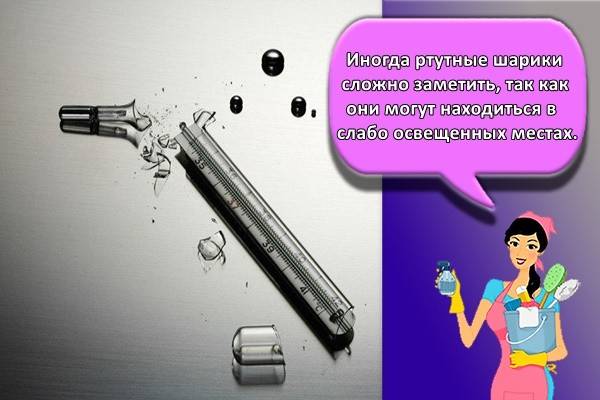
Disinfectant
After removing the mercury droplets, the surface must be treated with disinfectants that remove the remnants of mercury.
Potassium permanganate solution
Manganese mixture is considered to be an effective remedy against mercury balls. To create it, you need to add 50 grams of potassium permanganate with acetic acid and salt to a liter of water.
Bleaching powder
Another effective mixture is chlorine solution. To prepare it, you need to add a liter of bleach to a bucket of warm water. Then the mixture is applied to the floor and other coatings that have come into contact with mercury.
Cleaning even floor coverings
The easiest way is to clean a flat floor surface. To do this, collect all the mercury drops with a syringe or brush, and then disinfect the floor with manganese liquid or chlorine solution.
Cleaning carpet or carpet
It is more difficult to pick up mercury from carpets as it gets tangled in the pile. When cleaning the carpet, the balls will have to be collected with a syringe. After collection, the carpet is taken out into the street, wiped with soapy water and aired for 2-3 days.
Demercurization of the kitchen
If the thermometer crashes in the kitchen, you will have to dispose of all food that was not in the refrigerator. All dishes are washed several times with hot water and detergents. Dispose of towels and sponges in the kitchen as they may contain mercury particles.

What shouldn't be done with mercury?

It is strictly forbidden to sweep mercury with a broom, especially from a carpet. So you will only break up the particles of the substance, expanding the volume of vapor. It is also impossible to vacuum the infected area, otherwise a warm engine will increase the evaporation rate, and the vacuum cleaner itself will have to be thrown away later.
If balls of mercury get on things, then they should be destroyed. Machine wash is prohibited, as it will not save clothes - it will become dangerous in the future.
It is not allowed to flush the collected substance into the sink or toilet, as it is heavy and will most likely remain in the knee of the water supply. How long does it take to evaporate mercury in such conditions? Both long and intense. Thus, you will be constantly exposed to the influence of toxic fumes.
Even if a can with particles of poisonous metal has been carefully sealed, it must not be thrown into a trash can or garbage chute. It will break sooner or later and other people will be exposed to danger.
How does mercury enter the body?

For a person, it is not mercury itself that is dangerous, but the vapors that it releases. They can cause real harm to health and even human life. From a broken thermometer, a dangerous substance can enter our body in two ways. Either by mouth or by inhalation of toxic fumes.
We admit that the first option is extremely rare. There is a danger that a small and unintelligent child might taste the beautiful silver balls. Therefore, if there are children in your house when the thermometer crashed, the first step is to isolate them, and then decide where to throw the thermometer.
If, nevertheless, this happened, and the baby swallowed several mercury balls, then you should act immediately. They should spend as little time in the body as possible. Therefore, immediately induce the child to vomit and call an ambulance. Experienced doctors know how to help a person in such a situation, the main thing is not to hesitate. Otherwise, the consequences can be the most sad, up to and including death.
But the option when a person can inhale mercury vapor is quite common. Usually, this happens due to the most common negligence, unwillingness or ignorance of how to act in such situations, where to throw a broken mercury thermometer.
We collect mercury
First you need to change into clothes that you will not mind throwing out later. On the face - a gauze bandage. You also need to wear thick gloves and shoe covers.
In a glass container with a very tight lid, place the found balls of mercury, previously collected with a syringe or using tape. It is recommended to collect in bright light or using a flashlight to eliminate missing balls. The remaining fragments are placed in a solution of potassium permanganate.

After carefully collecting all the balls and moving the broken thermometer into a container with water (potassium permanganate), all this must be taken to a cold place. All surfaces that may come into contact with mercury are treated in a special way:
- For 1 liter of potassium permanganate - 1 tablespoon of vinegar and salt.
- Potassium permanganate can even be replaced with bleach.
- It is necessary to achieve the most concentrated solution possible.
- Having processed all the surfaces and the floor, we leave it for a day.
- The procedure must be repeated daily for 2-3 weeks.

Disposal
It is recommended to take the container with the prepared waste to the sanitary and epidemiological station. If this is not possible, then it is necessary to take everything that needs to be disposed of (clothes, syringe, gauze, gloves, shoe covers, a thermometer, a container with mercury) outside the settlements and bury it very deeply. We call specialists if:
- It is not absolutely certain that all the balls of mercury have been collected;
- At the time of the release of mercury vapor, people from the above risk group were in the room;
- The mercury got on the heating devices and evaporated.
Poisoning symptoms
Depending on how many people have been in the immediate vicinity of the broken thermometer, the symptoms that appear can make themselves felt even after a few weeks. The main symptoms: increased fatigue; nausea and vomiting; migraine; drowsy state; shaking hands; metal taste in the mouth; stomach pains.
If you find several symptoms at once, it is recommended to immediately consult a doctor.
Please note that if there are clear signs of poisoning received, you must immediately seek medical help. Immediately give the victim activated charcoal, milk

In order to make sure that there are no harmful substances left in the apartment, it is recommended to call specialists, and you can also purchase special devices for determining mercury vapors in the room.
How to collect mercury if a thermometer breaks
It can be difficult: drops of mercury are very mobile and easily clog behind the baseboards, in the cracks in the floor, the pile of carpets, and upholstery. The Ministry of Emergency Situations recommends What to do if a mercury-containing thermometer breaks, proceed as follows.
1. Remove the broken thermometer from the floor
You will need a glass jar with a lid or any other airtight container. A volume of 0.5–1 liters is sufficient. Pour water or potassium permanganate solution into the jar and carefully put the pieces of the thermometer collected from the floor there.
2. Look at things that may have been exposed to mercury
If you find any, collect them in a closed plastic bag. Later, when you finish cleaning the room, the contaminated clothing or toys will have to be disposed of. What to do if a thermometer with mercury breaks along with mercury and fragments of the thermometer. You cannot hope for washing - small metal particles will settle in the washing machine, and this is fraught with contamination of other things.
Dry cleaning or just throwing it away is also a bad option. Dry cleaning sometimes fails, and someone can pick up and use the thrown thing and use it, which is unsafe.
3. Collect the large balls of mercury
Move from the corners of the room to the center. With thick paper, cotton wool dipped in a solution of potassium permanganate, or with a brush, push the drops onto a sheet of A4 paper. Then brush the balls into the jar, where the fragments of the thermometer lie.
You can also use regular tape: glue a small piece on the floor where there is mercury, and tear off with the balls.Then send the tape with mercury to the jar.
4. Be sure to look for and remove small drops of mercury
They are more dangerous than large ones: their common surface is large, and therefore evaporation is more active.
Use a syringe, fine-tipped blower, or paintbrush to collect all the mercury residue and reach the smallest droplets in cracks in the floor, under baseboards and in carpet piles.
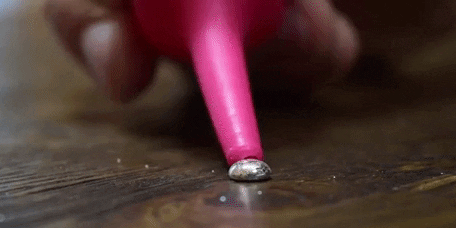 Video: Ministry of Emergency Situations of Belarus / YouTube
Video: Ministry of Emergency Situations of Belarus / YouTube
Attention! If there are a lot of small balls and the process of finding them is delayed, take a break every 15 minutes. What to do if a mercury thermometer breaks? and go outside for a few minutes. Close the jar with the collected mercury tightly with a lid and put it in a cool place, preferably on the balcony.
Fold the brush, paper, syringe and other materials at hand in a tight plastic bag. Tie it up and place it next to the jar
Close the jar with the collected mercury tightly with a lid and put it in a cool place, preferably on the balcony. Fold the brush, paper, syringe and other materials at hand in a tight plastic bag. Tie it up and place it next to the jar.
What to do with a broken mercury thermometer? Dispose of at home, is it realistic?
If the thermometer breaks, then its contents quickly flow out of the flask and, under its own weight, penetrates into the depressions and depressions that are found on furniture and floors. Mercury forms small balls with high mobility. Metal moves easily under the influence of vibration and even air. A feature of such balls is that they do not stick to any material, while having a high penetrating ability. Mercury penetrates into narrow crevices, holes, between the fibers of clothing and upholstery of sofas, into animal hair and human hair.
The most unpleasant thing is that regardless of the place where the metal has flowed out, it immediately begins to evaporate. The rate of formation of toxic volatile compounds is directly proportional to the ambient temperature. To prevent contamination of all rooms in the apartment, you need to collect and isolate the hazardous substance as soon as possible. But this must be done so as not to harm your own health and not spoil the interior elements. After that, you need to decide where to take the thermometer.
The general rules of action in a situation where a mercury thermometer breaks are as follows:
- Keeping calm. Panic can lead to misconduct and make the problem worse.
- The collection of metal must be carried out with open windows, but without a draft. You must use a gauze bandage and rubber gloves. A magnifying glass should be used to examine tight spots and tissue.
- The collected material is packed in plastic or glass containers with a sealed lid.
- Remove the container with glass shards and collected metal out of the reach of children and animals. This could be a pantry or a balcony.
- Clarify where to put the mercury from the broken thermometer. You can get the necessary information by calling the hotline 101 or 103. If employees do not give recommendations, then contact the Sanitary Epidemiological Service (SES).
What to do if the thermometer is broken
A broken thermometer is a very common problem, especially in families with children. After flowing out, the mercury is collected in small silvery balls.
It is very important to collect them as quickly as possible, as the fumes are toxic to both humans and animals.
Mercury collection activities
If a thermometer breaks in the house, follow this procedure:
- Remove adults, children and pets from the premises, close the door.
- Open the windows in the room, but make sure there is no draft.
- Cover your face with a mask, damp cloth, or gauze bandage.
Spilled mercury is collected in several ways:
- a medical syringe;
- rubber syringe (pear);
- cotton pads;
- bandage or gauze napkins;
- a piece of paper;
- any tape or adhesive tape.
After collecting, it is necessary to carefully examine the surface, for this it is convenient to use a flashlight. Be sure to collect the remnants of the glass from the thermometer, as small pieces can dig into the skin. It is recommended to use rubber gloves during work.
What not to do
It is strictly forbidden to pick up spilled mercury with a duster or broom. This will lead to the disintegration of the balls into fine dust, which is almost impossible to remove. Also, you can not use a vacuum cleaner, since the hot air flow increases the evaporation of the metal.
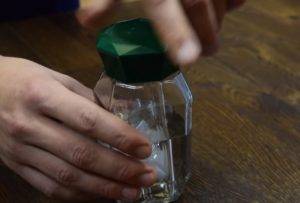 A broken thermometer and a jar of collected balls must not be thrown into trash containers. You cannot flush mercury down the toilet. The thermometer is placed in a jar where the mercury balls were collected, and then it is handed over to special demercurization centers that dispose of toxic metal.
A broken thermometer and a jar of collected balls must not be thrown into trash containers. You cannot flush mercury down the toilet. The thermometer is placed in a jar where the mercury balls were collected, and then it is handed over to special demercurization centers that dispose of toxic metal.
Danger of poisoning if the mercury is not completely removed
Not completely removed balls of mercury continue to evaporate into the environment. They are especially dangerous for people with chronic illnesses. The first signs of discomfort do not begin until a few weeks later. These symptoms include headaches, fatigue, weakness, irritability, etc.
Prevention measures
After cleaning the room and removing the mercury balls, the following measures should be taken:
- If mercury comes into contact with soft toys or other fluffy surfaces, it is recommended that they be burned or disposed of. You can also put these things in the sun, and after a couple of months, the mercury will completely evaporate.
- The contaminated surface is washed with a saturated solution of potassium permanganate. Bleach can be used instead.
- After wet cleaning, the room is well ventilated for 2-4 hours, but there should be no draft.
Evaporation rate of mercury
In one hour, 0.002 mg of mercury evaporates from a square meter. Thus, it is easy to calculate the rate of its evaporation in a living room at room temperature, multiplying this indicator by the total area (90 cm2) of the scattered balls: 0.002 x 90/10000 = 0.000018 mg / hour.
But at the same time, certain factors will always affect the speed of this process: temperature fluctuations, the quality of air circulation, the surface area of the scattered particles and the total amount of the toxic substance. After all, it is not always possible to collect all the mercury. Some of it can roll under the skirting boards, in cracks and small chips in the floors.
One small ball of mercury from a broken thermometer evaporates for a long time - at least 3 years. If the house has warm floors and rare ventilation, then this period will noticeably decrease, and, conversely, will increase with constant ventilation.

It can also be estimated how long it takes 2 grams of mercury to evaporate in a normally ventilated dwelling. Making simple calculations, we get a period of 30 years. But remember that everything is conditional.
If we talk about how long the mercury evaporates on the street, then here this period will also depend on the environmental conditions. It is known that under the influence of direct sunlight and air temperatures from +35 ˚C to +40 ˚C, the evaporation rate increases 15-17 times. In the cold season, it decreases accordingly.
And do not forget that over time, the rate of evaporation of mercury drops - after a couple of weeks, about twice, and so on.
Which is better - chlorine or potassium permanganate?
It is only in disaster films or action fairy tales that a hero appears who saves everyone and delivers them from inevitable death. In life, in any critical situations, it is better to do everything yourself and carefully, without relying on outside help, because only in large cities there are services professionally engaged in the disposal of household problematic waste and cleaning the premises in accordance with the danger that has arisen.To get rid of the dangerous consequences of a crashed thermometer on your own, it is best to use improvised means that are no less effective than those of specialists.
You can neutralize the remnants of mercury with potassium permanganate or bleach. The solutions must be concentrated, which means that they are sufficiently caustic. In 1 liter of potassium permanganate solution, pour 1 tablespoon of vinegar essence and add 1 tablespoon of ordinary salt. Potassium permanganate for cleaning will have an almost black tint, and it will definitely leave indelible marks on the floor surface. It is more convenient and easier to use chlorine-containing products for cleaning and disinfecting at home, the same "Whiteness" for example. This agent is used to treat the surface after mercury for 15 minutes, then rinsing with clean water. This cleaning should be repeated as often as possible within 2-3 weeks.

What's happening?
Mercury is dangerous for all living things, it disrupts metabolic processes, a person initially feels weakness and apathy, which over time develop into disruptions in the work of all organs: the kidneys, liver, heart, lungs suffer from an excess of mercury in the body. Death can be caused by mercury poisoning from a thermometer. The symptoms and effects of inhaling mercury vapor, or worse, ingestion of mercury by mouth, can be dire.
Mercury poisoning, like any other toxic and hazardous substance, can be acute or chronic. Acute poisoning is characterized by headache, vomiting and salivation, sore throat and abdominal pain, swelling and bleeding of the gums, body temperature may rise. Acute poisoning occurs approximately 2 hours after a significant dose of mercury has entered the body.
Chronic poisoning is the result of prolonged inhalation of low concentrations of mercury vapor. It often develops in those people in whose home a mercury thermometer was once broken, but the cleaning and neutralization of the substance was not carried out as it should have been.

Instructions: how to collect mercury from a broken thermometer
If you accidentally break your thermometer, don't panic. Your first priority is to collect the mercury as quickly as possible (Figure 1).
In every home there are items that will help you do this:
- A paintbrush, paper or a piece of cotton wool: the liquid metal must be pressed into one ball with a piece of paper. After that, with a brush or cotton wool, they are transferred to a sheet and poured into a jar.
- Syringe or syringe: the syringe is clamped in the hand, brought to the ball of mercury and slightly loosened the grip so that the mercury is absorbed inside. In the case of using a syringe, the ball is pulled inward according to the principle of liquid intake.
- Adhesive plaster or tape: with their help you can easily collect the smallest fragments of glass from a broken thermometer and small balls of mercury. To do this, you just need to stick the tape on the surface where the thermometer was broken.
You may also need a flashlight and a thin needle. Using the first device, they carefully examine the surface so as not to miss the smallest balls of liquid metal. A spoke is needed if the mercury is in a hard-to-reach place and needs to be removed from there.
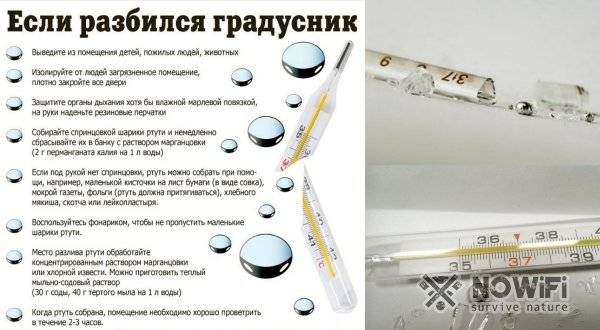 Figure 1. It is better to collect liquid metal with a syringe or syringe
Figure 1. It is better to collect liquid metal with a syringe or syringe
Regardless of the way in which the mercury will be collected, the liquid metal itself and the object that was used to collect it are placed in a jar of disinfectant solution. We will talk about its preparation below.

